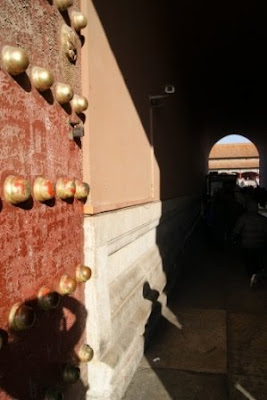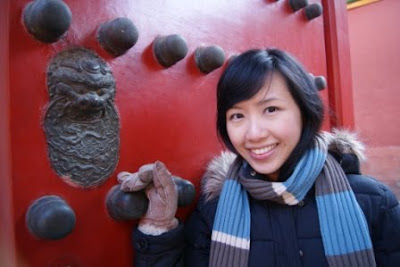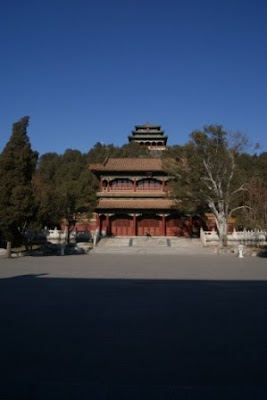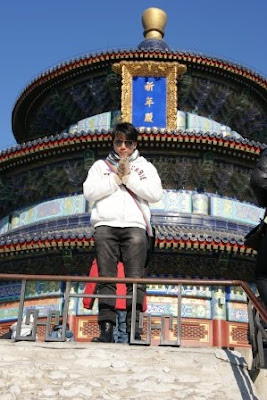December @Beijing Part II_Palaces and Temples
Beijing (8 - 14 December 2011)
The trip last year to Beijing was so brief that I could not even sense any imperial breath in the air. This trip however, was all about it.
Palaces, gardens, structures and architectures, and lots of walking.
And it was -10 degrees on most days!
FYI - All official taxis (出租車) have license plates beginning with the letter "B", as in "京B". "Black cabs" may look like taxis but their license plates will start with letters other than B. It starts from 10RMB. Rather affordable. Of course, the train system in Beijing is good enough, at 2RMB per trip, you can take to any stops you want.
We arrived at 2am the night before, and we were in no mood to travel far the next morning.
Fortunately, our hotel is just beside the walls of the Forbidden city (故宫博物院) and that was our first stop.
Forbidden City (故宫博物院)
Housing the royalties of the Ming and Qing Dynasty over 500 years, this UNESCO heritage site is a must visit in Beijing. 980 buildings which covers 720,000 square metres, you can imagine the extensiveness of this place.
The Chinese believed in the protection by heavenly creatures, you will find these celestial animals on the roofs and entrances of the main halls.
You will be able to find such huge 'pots' outside each halls, they are meant to provide warmth by burning charcoals during the winter and to hold water during the warmer seasons in case of fire.
Halls after halls, you just keep walking and peeping into the interior of each hall, where the imperial bodies once had their presence made. The gold that you see is pure gold by the way... Dull and unpolished, but they are priceless.
The ancient doors and walkways...
We heard people whispering if the people who once lived here ever lost their way in here!
One end of the walkway to the other was quite a distance by the way!
I did a stunt, trying to figure how high the walls are for the ancient kungfu people to 'fly' over...
Jing Shan Park
Exiting the palace, you could see this park in front of you. We spotted a palace on the top of the park and thought that would be a good place to see the overview of the Forbidden City, and we were right.
The view was spectacular!
We spotted mandarin trees in the park, a very pretty sight.
It made us hungry and we took a timeout for lunch before heading for shopping at Wangfujing.
~~~
Tiananmen Square - Flag Raising Ceremony

The guards returning into Tiananmen and that was when you could move to the front of Tiananmen to take pictures.
A walk back to our hotel at night, we passed by the Tiananmen again - very nicely lit.
We then went across to the other side of the road where the flag was situated, the Tiananmen Square. Security check at Tiananmen square is stringent. You have to put your bags under the monitoring belt before you are allowed to enter the Square.
Mao Memorial
A highly secured memorial hall located at Tiananmen rested Mao Zedong (1893-1976), a Chinese Communist revolutionary and the founding father of People's Republic of China in 1949. If you wish to enter the memorial which is free admission, you need to deposit all handcarry belongings at a nearby 'deposit banks' located around the Tiananmen Square. I was quite skeptical at first as I had my important items in my little bag, but even that bag could not be brought into the memorial hall. We had to leave all our belongings at the deposit bank.
Entering the memorial hall is solemn - only whispers and footsteps.
It's a one way in and one way out.
You enter into the hall, walked past a huge tablet where people buy and place flowers on, led to the back of the tablet is the coffin of the resting Mao Zedong whose body was embalmed, before exiting the hall.
The Temple of Heaven (天坛)
A complex of Taoist building visited by the Emperors of the Ming and Qing Dynasty.
Constructed in the 1400 by Emperor Yongle, who was also the one behind the construction of the Forbidden City, the architectural masterpiece of the temple was named a UNESCO Heritage site in 1998. Besides being a popular tourist attraction, this place has now been transformed into a leisure park where the locals come for exercising, singing, performing, and even playing poker and 'mahjong'!
The Hall of Prayer for Good Harvest (祈年殿) is a popular postcard picture of Tian Tan.
A triple decked circular building, built on marble stones base. The building is made completely out of wood, with no pillars. It is supported by triangular pieces on the edges, we saw this in the other temples we visited too. The original building was struck by lightning in 1889 and was burnt down, only to be rebuilt years later after the incident.
The Imperial Vault of Heaven (皇穹宇) has echo walls around it, which is believed to be able to transmit sounds from one end to the other. We tried... cannot leh. :p
The Circular Mount Altar (圜丘坛) hosted sacrificial ceremonies to help prayers communicate with Heaven.

Funny story of this door! Read this!
There are many trees in the park which most of them are labelled as 古树 (Ancient Tree), and are over hundred years old.
Summer palace (颐和园)
A summer resort for Empress Dowager Cixi who diverted funds used for the Chinese navy to reconstruct this place which came under attack by the Anglo-French Allied invasion in 1868 and the Boxer Rebellion in 1900.
And more climbing....
I was wondering what he was looking at... There was nothing.
Palaces protected again by celestial creatures.
The one on the left is Qi Lin, a popular celestial creature of dragon head and scaly body.



A stroll around the Kunming lake, people stopped by to enjoy the breeze or take a rest at the Pavilions. There is actually river cruise around Kunming lake but as you can see, the lake was frozen.


It was so calm and relaxing, I love this place. We even had ice cream!

Old Summer Palace (圆明园)
Built on a larger scale as compared to the Summer Palace, this old Summer Palace was built in the 18th and early 19th century where Qing Emperors resided and handled government affairs at.
After visiting the Summer Palace, we made our way to the old summer palace, which was somewhat forgotten after the facelift of the Summer Palace by the Dowager. It was under attacked during the 1868 by the Anglo French as well, and the destruction was conspicuous to date as the place was left very much as it is on some parts of the garden.
Stalls selling interesting stuff, like this sugar treat where the seller uses a straw to blow the hardened sugar into shapes of animals. Hmm... not sure if this is hygienic..
This maze garden was said to be the playground for the Emperors and Courtesans. The Emperor would be standing at the pavilion and any lady who reached the pavilion first would win a look at the Emperor himself.
There are influences of the Western community at the complex, where a part of the garden was dedicated to the designs by Jesuits Giuseppe Castiglione and Michel Benoist. Employed by Emperor Qianlong, they constructed the European style palaces (西洋楼), made of stones (Chinese palaces are often made of wood) which very much survived the destruction.
Sunset at Yuan Ming Yuan
Yonghegong (Lama Temple) (雍和宫)
Emperor Yongzheng's coffin is housed in this temple.





A Guiness world record was set in this temple in 1993 where a 26m tall statue of Maitreya Buddha was carved from a single piece of sandalwood. Sorry, no photo-taking inside the temple itself.

This temple was built in honour of the great teachings of Kong Zi, established in 479BC, visited by royalties from several Dynasties.





This is a Hall where Emperors would take on the throne and pass teachings of Confucianism to the people. No common man could enter the hall when the Emperors were present, and these teachings would be passed through officials all the way to where the common men were outside this hall.

This 700 years old Cypress tree had an interesting story which we would not have noticed until a tour guide was explaining to her group. Folk stories had it that a famous corrupted official from the Ming Dynasty visited this temple and was knocked off his official hat by the branch of this tree. People since then believed that this tree could distinguish good and evil. Look at the strange image on the trunk of this tree, as if its a hand grabbing onto something 'evil'. This tree is known as 'Touch Evil Cypress" (触奸树)。


The many offerings made to Kong Zi, in the form of a red tablet.

















































































































No comments:
Post a Comment